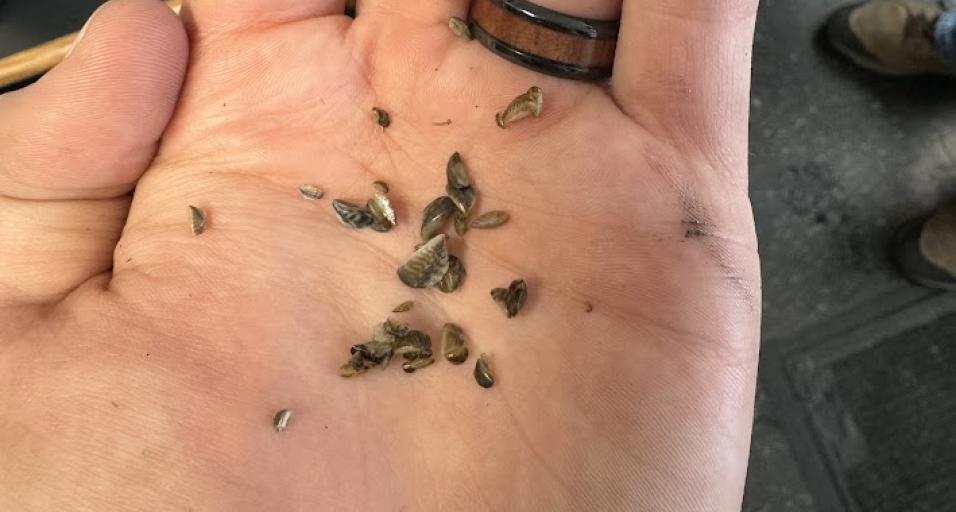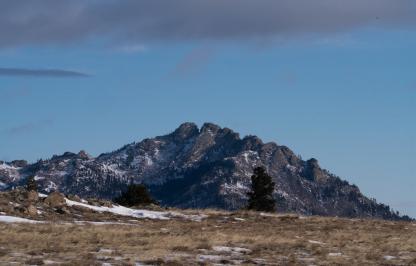A watercraft harboring live, invasive zebra mussels was intercepted on Sept. 22 at the northeast Wyoming border by the Wyoming Game and Fish Department. This was the first watercraft with verified live mussels discovered at a Wyoming check station this year.
The compliant boater assisted Game and Fish by stopping for the inspection. Upon discovery of the mussels, inspectors at the Beulah aquatic invasive species check station immediately began decontamination of the watercraft. Inspectors removed live zebra mussels in multiple water intakes, along the pontoon and in other areas of the inspected boat. The watercraft had been moored for several months in South Dakota’s Pactola Reservoir, where a population of mussels was discovered in 2022.
The findings of the mussel-fouled watercraft is a stark example of the importance of watercraft inspections. Prior to the program’s expansion, inspection stations in Wyoming would have been closed for the season at this point in the year, and the boat may have gone unnoticed.
“When the AIS Program launched in 2010, our stations were only open for the main boating season,” said Josh Leonard, AIS Coordinator for the Wyoming Game and Fish Department. “In the last few years, given the increased threat of AIS we recognize the need to stay open into the shoulder seasons, when the bulk of boaters are off the water. Situations like this demonstrate the threat is at our borders—knocking on Wyoming’s door. Everyone in Wyoming, or coming to Wyoming, should be concerned and get involved.”
Zebra and quagga mussels are aquatic invasive species that can wreak havoc in freshwater ecosystems, including causing damage to property like watercraft, ruining shorelines, harming fish populations and causing a decline in tourism.
In addition, mussels can clog dam systems, municipal water pipes, irrigation systems and treatment facilities. An infestation in just one of Wyoming’s water treatment facilities could cost hundreds of thousands of dollars annually to remove mussels, keep water flowing and mitigate damage — costs that could be passed on to all water users.
Wyoming remains one of only five states in the continental United States that are mussel-free, with every state bordering Wyoming, except Montana, having at least one waterbody containing mussels. However live, adult mussels can begin reproducing the moment they hit the water if the conditions are right, so a watercraft harboring these animals could easily start a new population. Inspections are the first line of defense for many watercraft, and cases like this serve as a reminder for sustained vigilance.
“Our inspectors see thousands of boats every year,” said Reed Moore, AIS Specialist for the Sheridan region. “Since the discovery of zebra mussels in Pactola, our inspectors at Beulah have conducted hundreds of decontaminations. Over 50% of the watercraft inspected there are considered high risk for transporting AIS. Luckily the risk of this watercraft was minimized by our technicians and compliant boaters.”
Watercraft inspectors statewide have inspected over 73,000 boats and conducted 1,121 decontaminations this year. They also intercepted 43 other boats containing non-viable invasive mussels.
Any watercraft transported into Wyoming from March 1–Nov. 30 must undergo a mandatory inspection by an authorized inspector prior to launching on any Wyoming waterway. It’s state law that anyone with a watercraft must stop when coming upon an open AIS inspection station — even if they stopped at one prior or do not intend to launch in Wyoming. This applies to all motorized watercraft, as well as non-motorized watercraft such as kayaks, canoes, rafts and paddleboards.
Anyone interacting with Wyoming’s waters, including boating, fishing and recreating, can help keep these invasive mussels out of our state by always practicing Clean, Drain, Dry procedures. This means cleaning watercraft and equipment of mud, plants and debris, draining any standing water, and drying everything before transport, especially when planning to use the equipment in a different waterbody.
— WGFD —
Additional information and frequently asked questions
What happened and why was decontamination necessary?
Game and Fish inspectors discovered live, invasive mussels on a watercraft during a high-risk inspection, which was conducted based on the last water the watercraft had visited. This watercraft had been moored for several months in South Dakota’s Pactola Reservoir, where a known population of zebra mussels exists. The presence of mussels in that waterbody, combined with the amount of time the watercraft spent in the water, indicated that the watercraft was at higher risk for harboring mussels. Once they were found, inspectors immediately began a decontamination process to kill and remove all mussels from the watercraft. This process consists of spraying and soaking the watercraft and equipment with very hot water. Once the process was completed, the watercraft was released back into the custody of the boat owner.
Why does it matter?
The mussels on the intercepted watercraft were live adults. Zebra mussels can live outside of water for up to 30 days in the right conditions, and they can begin to reproduce as soon as they are resubmerged. If this watercraft had not been inspected and had launched in a Wyoming waterbody, a new population of mussels might have become established.
Why are mussels bad?
Zebra and quagga mussels are aquatic invasive species that can wreak havoc in freshwater ecosystems once they are introduced. One adult mussel can spawn up to one million young each year, creating explosive and exponential population growth. Their offspring are microscopic and float through the water column until they grow big enough to settle out and establish in a new area. These animals usually grow to about an inch in diameter, but they carpet underwater landscapes. Zebra and quagga mussels grow thick, strong, hair-like threads called byssal threads, which allow them to attach to hard and semi-soft surfaces including rocks, water intake pipes, boat docks and boat hulls. These mussels grow so densely that they can clog boat engines, pipes used for irrigation and water treatment facilities as well as interfere with dam operation. For example, the 40 DEQ-permitted water facilities in Wyoming could each spend hundreds of thousands of dollars annually to keep water flowing, and costs could be passed on to water users.
Additionally, mussels interfere with the balance of freshwater ecosystems, especially given a large population. Mussels filter out food fish eat, potentially leading to a decline in fish. If fish become scarce, Wyoming could be hit with a multi-million dollar decline in tourism dollars from recreational fishing. Zebra and quagga mussels also outcompete native mussels for resources and crowd out other invertebrate species. Their shells are sharp, and when the animal dies the shells stick around, covering the bottoms of lakes and rivers and beaches with razor-like fragments.
What can I do to help?
The Wyoming Game and Fish Department encourages anyone interacting with water to follow Clean, Drain, Dry protocols. Any and all watercraft, associated boating equipment and fishing gear need to be cleaned after every use, especially between uses at different water bodies. This means no mud, dirt, plants or other debris should be left. All water should be drained from bilges, coolers, boots and anything else that can contain water. As juvenile mussels are microscopic, thousands could be floating in just a small bucket of water, and they would be undetectable to the human eye. Lastly, leave everything out to dry between uses. Invasive mussels, along with some other aquatic invasive species, can live outside of water for up to a month in humid, tepid conditions. The longer you can let equipment dry, the less likely it is that any aquatic species can survive and start a new population.
If you are traveling with a watercraft, you must stop at any open inspection station along your route of travel. Most check stations are located near state borders, but there are stations at some waters inside Wyoming’s borders as well. Any watercraft transported into Wyoming from March 1–Nov. 30 must undergo a mandatory inspection by an authorized inspector prior to launching on any Wyoming waterway. It’s state law that anyone with a watercraft must stop when coming upon an open AIS inspection station — even if they stopped at one prior or do not intend to launch in Wyoming. This applies to all motorized watercraft, as well as non-motorized watercraft such as kayaks, canoes, rafts and paddleboards. It is also required for anyone launching a watercraft in Wyoming to purchase an invasive species decal sticker. The funds raised from decal sales directly fund the AIS program.
If you don’t own a watercraft, fish or recreate in Wyoming’s water bodies, you can still help by spreading the word about stopping the spread of invasive species. The introduction of invasive mussels would have negative effects on all Wyoming residents.


